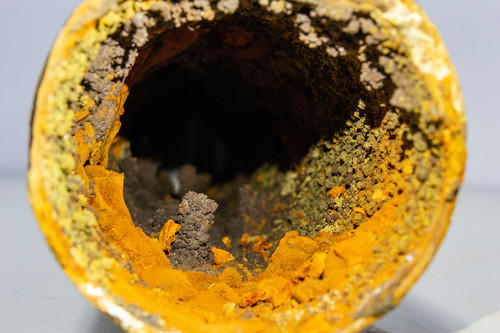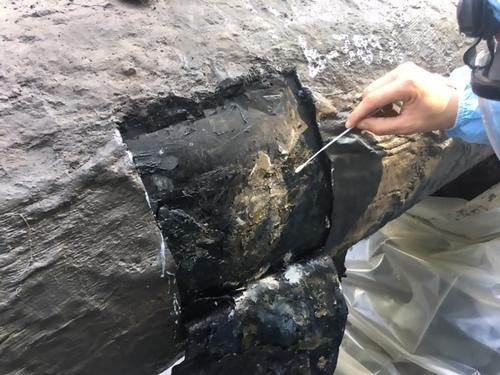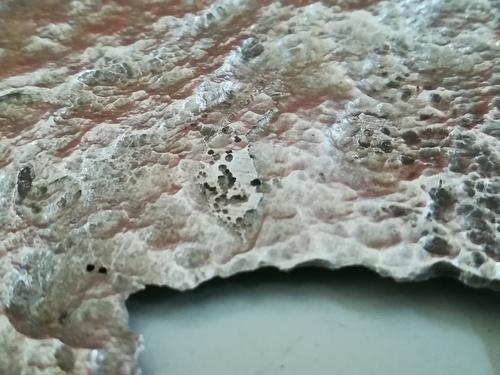
In our consultancy work, we regularly come across well-intentioned actions by clients that cause unintended reactions, such as the development of MIC (microbial corrosion). At first sight, these are often very logical actions which, unfortunately, can have major consequences. We have listed five of them for you. These experiences of others may help you to prevent similar problems.
Oxygen scavengers are often used in liquid streams to prevent oxygen corrosion (for example in oil and gas production facilities). A widely used and effective agent is sodium bisulphite (NaHSO3). In and of itself this is an excellent way of preventing oxygen corrosion in pipelines. Inadvertently, the sulfur source in sodium bisulfite can also be used as a food source by sulfur-related bacteria, which then produce acids. This can cause accelerated microbiological corrosion (MIC), resulting in a very low acidity locally on a pipe wall and possible leaks.
Transport pipes are sensitive to the development of MIC. The outside of transport pipes is therefore often protected by cathodic protection and a coating. The inside does not have this protection and must therefore be cleaned regularly to prevent microbiological contamination, among other things. This can be achieved by mechanical and chemical cleaning. Mechanical cleaning is performed by pigging of the pipe and chemical cleaning by using a biocide. However, this action in itself does not guarantee a long residual lifetime. The manner in which the cleaning action is carried out determines its success. For example, is the chosen pig sufficiently capable of removing the contamination? Is the contact time of a biocide long enough to have an effect on attached microorganisms? If this is not properly coordinated, then a well-intended action leads to a false sense of security, in which MIC processes can continue more or less unhindered.
A coating of an underground transport pipe has an expiration date. When the coating is damaged by the test of time, it becomes sensitive to the occurrence of corrosion processes (including MIC). That is why it is wise to provide pipes with a new coating on time. Especially in situations where a transport pipeline can no longer be easily reached, for example underneath a crossing motorway. Yet it is precisely in those situations where coatings are replaced that we see unexpected corrosion. This can often be traced back to the construction period or construction method. Transport pipes are often exposed to moisture, soil (= micro-organisms) and oxygen for a long time. In combination with insufficient cleaning before applying a new coating, this can lead to microbiological corrosion. In this way the action intended as a preventive measure leads, in fact, to corrosion.

Sprinkler systems can be susceptible to corrosion, especially oxygen corrosion and MIC. If corrosion occurs, this can have consequences for the effectiveness of the sprinkler system, because it can cause blockages in the pipes, for example. A frequently used method to prevent this is regularly flushing the system with water in order to remove the corrosion products. Unfortunately, in these circumstances this action can worsen the problem. By flushing a sprinkler system, oxygen and nutrients are supplied for the bacteria every time, which accelerates the MIC processes. The result: more blockages and even leaks in the sprinkler system!
In the Netherlands there are almost 200 data centers that ensure the smooth running of our internet traffic. Data centers worldwide use about 1% of all energy, of which one third is used for cooling the server rooms. The most commonly used cooling method is a heat wheel with aluminum fins placed on the roof. The heat from the data centers is cooled in this system by heat exchange with the outside air. If the outside temperature is too high, a heat exchanger with an adiabatic cooling system can be used, whereby the outside air is cooled by evaporation of water. In and of itself this is a great action to achieve sufficient cooling. Still, this can lead to unexpected reactions. If the nozzles do not nebulize the water properly and the moisture particles are too large, the aluminum fins will become too wet and galvanic corrosion will occur. This is not the only problem, because if the moisture remains on the slats for a long time, bacteria may start to grow and produce acids. Unintentionally, this creates an aggressive environment where corrosion causes a lot of damage and extremely high costs.


If you want to know more, please contact Rob Elzinga, elzinga@microbialanalysis.com